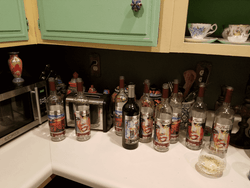Barbera is a grape variety belonging to the Vitis vinifera family, also known as the “European wine grape”. Barbera wine goes under several different names that refer to where it was made. This includes Barbera d’Alba, Barbera d’Aosta, Barbera d’Asti, and Barbera del Monferrato. As you go through Italy region by region, the synonyms for Barbera wine only keep coming.
They include but are not limited to: Besgano, Barbexinis, Pignatello, Perricone, Lombardesca, etc.
History of Barbera Wine
While Barbera is commonly grown in California’s Sierra Foothills today, that was not always the case. Italian farmers were growing Barbera all over the United States before prohibition in the 1920s-30s. After which, they were shut down for the most part. In 1986, Time reported that eight Italians and over thirty more were hospitalized after drinking Barbera. It was revealed that illegal wine additives were being used all over Europe.
How Barbera Wine is Made
Barbera grapes have high acidity and are often mixed with varieties that lack the same components. This helps to balance or soften the result without adding sugars. In the 1970s, French enologist Emile Peynaud recommended that Barbera producers use small oak barrels for fermentation. A short while later Giacomo Bologna began to mature his wine in barriques as recommended at his winery Braida.
Thanks to the work of Giacomo Bologna and Emile Peynaud, Barbera is now commonly enjoyed and is a wine for the people. Even more so now, because it can be experienced by everybody. It is reasonably priced and it can be found online for those who want to try different regional varieties. While it is rare to find outside of certain parts of Italy, there are even some varieties that are sparkling.
Wine Regions & Differing Flavor Profile
While Barbera wine may have first planted its roots in northwest Italy, it has not stayed there exclusively. Barbera is grown primarily in Italy’s northwestern low slopes and valleys at nearly 52,600 acres across Alba, Aosta, Asti, Monferrato, Puglia, and Sardinia. Barbera has also found its home in the sandy soils of Argentina (1.3 thousand acres in San Juan and Mendoza), Australia (two thousand across Mudgee, McLaren Vale, and Adelaide Hills), and the United States (seven thousand in the Sierra Foothills, Central Valley, and Santa Barbara).
Getting a Barbera wine made in the United States, would get a fruitier flavor profile than Barbera wine made in Europe. In Europe, Barbera wine is typically herbaceous and acidic. On the other hand, wine coming out of the United States can often have stronger notes of vanilla, cherry, blackberry, etc. It depends on the conditions the grapes were raised and matured.
Is Barbera Wine Good? Food and Spice Pairings
Food pairings and recommendations will differ depending on what part of the world you are in. In the United States, Barbera wine typically has fruitier notes and less acidity. This makes it more open to pairing with a spicy dish. If you are in Piedmont, Italy, or close you may want to pair your Barbera with dark meats such as pork roast or braised lamb. Additionally, Italian-style stews with tender meats such as rabbit or duck and mushroom risotto are also fantastic options. Seriously, the list could go on for ages!
In short, Barbera goes well with dark, rich meats and anything that can enhance or compliment that umami flavor. For example, meaty mushrooms or root vegetables that are higher in tannins. Barbera is acidic with fruity notes, allowing it to stay light. This is exactly why it’s perfect to complete a more hearty dish. On your next outing, you may want to think about treating yourself to some Barbera wine.





